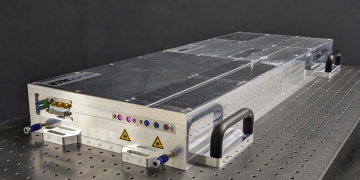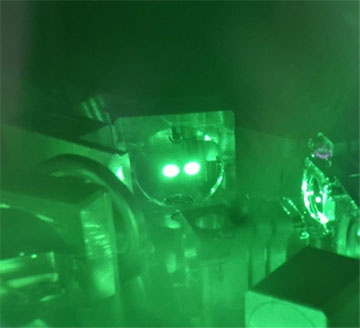
The compact single-cavity dual-comb laser system developed in Ursula Keller’s group at ETH Zurich, Switzerland. [Image: ETH Zurich/D-PHYS Benjamin Willenberg]
A research team led by Optica Fellow Ursula Keller at the Institute for Quantum Electronics in Zurich, Switzerland, has demonstrated a new design for a single-cavity dual-comb laser for reliable optical delay scanning with long-term stability (Optica, doi: 10.1364/OPTICA.457787).
The simplified design could help bring about the commercialization of a new class of ultrafast pulsed lasers that could find use in a variety of applications, including pump–probe sampling, optical ranging and high-resolution gas absorption spectroscopy.
Splitting the cavity with a biprism
Producing a sustained series of repeated laser pulses is key to many high-precision applications, including distance and spectroscopy measurements. One approach to generating such laser-pulse series is to split a laser output into two beams and then varying the pulse rates. However, scientists using current dual-optical-frequency-comb approaches struggle to create practical systems with a simple design that provides high-quality and highly stable pulses.

The spatially separated cavity modes are being reflected off a mirror. [Image: ETH Zurich/D-PHYS Benjamin Willenberg]
Keller and her team’s breakthrough approach to the single-laser, dual-comb problem includes using a highly reflective biprism to split a single laser cavity mode into two parts. This allows for the spatial separation of two combs with distinct spacing for generating different pulse rates while maintaining nearly identical optical characteristics. The biprism can also be adjusted with a piezoelectric actuator, allowing for tuning the repetition-rate difference between the two combs from -450Hz to 600 Hz.
Characterization and demonstration
Before demonstrating their single-cavity dual-comb laser system, the researchers first characterized both of the combs. Each output beam achieved simultaneous mode-locking with 2.4-W average power with pulse durations of 138 fs for the first comb and 132 fs for the second comb.
Next, Keller and her colleagues confirmed the effectiveness of the single cavity for obtaining two laser pulse trains with low, sub-cycle relative timing jitter (25 dB lower than the absolute timing jitter spectrum across almost all frequencies).
In a demonstration setup for pump–probe spectroscopy applications, the researchers coupled an 80-MHz solid-state laser with an optical parametric oscillator to produce a multicolor structure for pump–probe sampling applications. To improve pulse stability, they implemented a slow cross-correlation-based feedback loop on the biprism position to remove slow environmental drifts that could change the repetition rate. The resulting benchmark, which the team declared “highly encouraging,” was a 12-ns optical delay with 2-fs precision at rates up to 500 Hz over five hours.
